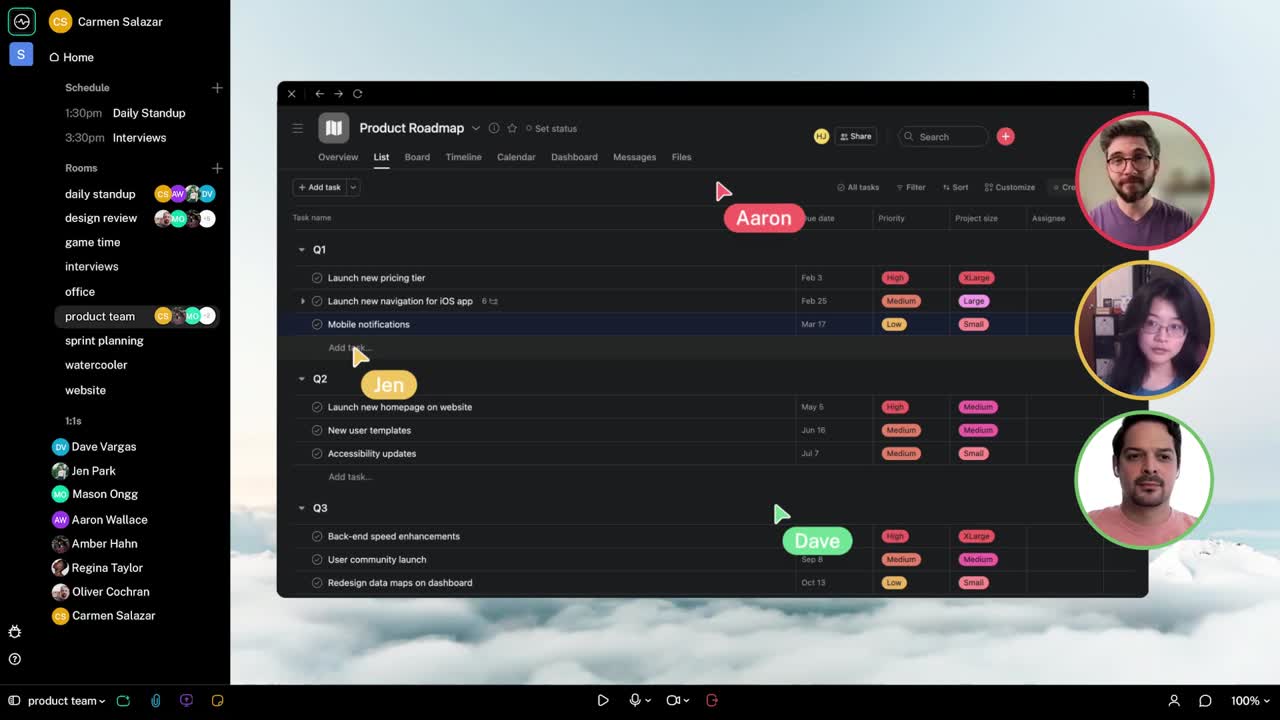Switchboard, a collaboration app that combines features of videoconferencing and digital whiteboarding, today announced that it raised $25 million in a Series A round that values the company at $200 million post-money. Icon Ventures led the tranche with participation from Sequoia, XYZ, and Spark Capital, bringing Switchboard’s total raised to $38.4 million.
Co-founder and CEO Amir Ashkenazi told TechCrunch that the fresh capital will be put toward building out Switchboard’s team and product.
“I founded Switchboard in June 2020, and it actually came out of a frustration with remote guitar lessons that I was taking. My teacher and I couldn’t bring the tools we needed into the online lesson — things like a metronome, a PDF viewer for notes and sheet music, a media player for back tracks, a second camera to see fingerpicking, etc.,” Ashkenazi said in an email interview. “What I realized was that all our current ‘collaboration’ tools are really just communication tools, enabling text, audio, video communication, or sharing a screen but not actually doing things together. This was a problem not only for my music lessons but for remote work across the globe, where teams are trying to build products, manage projects or brainstorm new ideas together. What started as technology for better guitar lessons evolved into Switchboard: a cloud co-working space purpose built for remote work.”
Ashkenazi was previously the president of AOL platforms before co-launching Tookee, an AI and voice tech company that LogMeIn later acquired for an undisclosed sum. Ashkenazi is the sole founder of Switchboard, whose initial team includes ex-Databricks software engineer Chris Jones, Marco Iacono and Daniel Shteremberg — the last of whom was the senior product manager at Zoox before Amazon purchased it in 2020.

Image Credits: Switchboard
Switchboard allows users to run multiple web-based apps including Google Docs, Figma, Trello and Jira in a single “virtual room.” Instead of toggling between tabs and apps or having to share someone’s screen, Switchboard is designed to bring materials to a shared space. For example, users can create permanent public and private rooms that keep apps and files for projects and recurring meetings open the next time they’re ready to collaborate. Each room features a “meeting memory,” which includes a history of chat threads and any of the content shared.
Ashkenazi claims that Switchboard traffic between a user’s client and the company’s infrastructure is encrypted in flight and at rest. The company doesn’t sell the data it stores and has no plans to do so.
During the pandemic, as many workers transitioned from in-office to work-from-home setups, the market for digital collaboration apps exploded. Back in 2020, a report from White Star Capital estimated that $35 billion of venture capital money was invested globally in collaboration companies including Postman, Workvivo, Slack and Zoom between 2017 and 2020.
“We started Switchboard during the pandemic as a response to tools that were not created for true collaboration,” Ashkenazi said. “It’s not a hard sell … Remote work saved our economy during the pandemic and now we’re seeing it emerge as a preference for many workers. [But companies] have firsthand experience with some of the limitations of videoconferencing: concerns about sharing their personal desktop, fatigue from staring at faces all day and frustrations with having to re-share what was shared in the meeting through screen sharing or chat.”
When asked about the competition, Ashkenazi says that he sees Switchboard’s rivals falling into a few different categories — namely videoconferencing, virtual office and vertical collaboration. But he argues that none of them adequately address the challenges Switchboard was designed to overcome.

Image Credits: Switchboard
“Virtual conference tools like Zoom or Google Meet are great for communication. But they won’t work with any web-based app, don’t make any website instantly collaborative and don’t offer permanent rooms for meetings and projects, nor do they offer an expansive space for visual collaboration,” Ashkenazi said. “Meanwhile, vertical collaboration tools like Figma and Miro offer a space for visual collaboration and some communication tools but are more focused applications for design and whiteboarding, respectively.”
Ashkenazi declined to say how many customers or users Switchboard has. But he asserts that the platform is “growing quickly” and seeing sign-ups from “startups to agencies to higher ed.”
“The communication tools and apps we use to get work done are only loosely connected and the only option we have to connect them is screen sharing. The industry is suffering from too many tools and not enough cohesiveness,” Ashkenazi said. “We think remote will be the future of work if we have the right tools to truly support it. Collaboration tools should combine communication and the applications we use seamlessly. The challenge is really one of workforce behavior, where video conferencing and screen sharing is deeply ingrained in our behaviors. But most workers also realize how inadequate those tools are and want something better.”
Switchboard has 22 employees currently and plans to increase that number to 36 by the end of the year.

